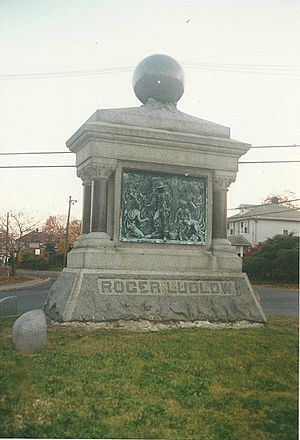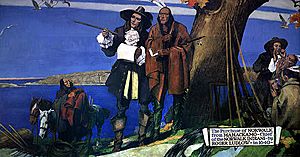Roger Ludlow facts for kids
Quick facts for kids
Roger Ludlow
|
|
|---|---|
 |
|
| Deputy Governor of the Massachusetts Bay Colony | |
| In office 1634–1635 |
|
| 1st, 4th, and 10th Lieutenant Governor of Connecticut | |
| In office 1639–1640 |
|
| In office 1642–1643 |
|
| In office 1648–1649 |
|
| Personal details | |
| Born | March 1590 Dinton, Wiltshire, England |
| Died | 1664-1668 (age 74-78) Dublin, Ireland |
| Spouse | Mary Cogan |
| Alma mater | Balliol College, Oxford |
Roger Ludlow (born 1590, died between 1664 and 1668) was an English lawyer and leader. He was very important in starting the Colony of Connecticut. He also helped write laws for both Connecticut and the Massachusetts Bay Colony.
Roger Ludlow, along with John Mason, helped build Boston's first fort. This fort was first called Castle William, then Fort Independence. Roger Ludlow often disagreed with other leaders. He later founded the towns of Fairfield and Norwalk before leaving New England.
After a short time in Virginia, Ludlow went back to Europe. There, he was given a job by Oliver Cromwell to help manage property in Ireland. He also worked as a judge in Dublin, where he is thought to have passed away.
Contents
Early Life and Moving to America
Roger Ludlow was born in March 1590 in Dinton, Wiltshire, England. He was the second son of Sir Thomas Ludlow and Jane Pyle. He studied at Balliol College, Oxford around 1609 or 1610. He also became a lawyer in 1612.
In May 1630, Ludlow sailed to America on the ship Mary & John. His wife, Mary Cogan, was the sister-in-law of Governor John Endicott of Massachusetts. They settled in Dorchester, Massachusetts, and lived there for five years.
During his time in Dorchester, Ludlow became a judge in the Massachusetts Bay Colony. He was chosen as Deputy Governor in 1634. He also successfully made the first agreement between the English settlers and the Pequot people. In 1635, he lost the election for Governor to John Haynes.
Starting the Connecticut Colony
In 1635, Roger Ludlow joined other Puritans and Congregationalists. They were not happy with how slow the church reforms were in England. They wanted to create their own religious society with their own rules.
The Massachusetts General Court allowed them to start new towns in what is now Connecticut. These towns were Windsor, Wethersfield, and Hartford. The Ludlows settled in Windsor.
However, there was a disagreement about who owned the land along the Connecticut River. The English holders of the Warwick Patent of 1631 claimed the land. The Massachusetts General Court formed the March Commission to help settle this argument. Roger Ludlow was put in charge of this group.
The Commission chose eight judges from the Connecticut towns to create a legal system. The March Commission ended in March 1636. After that, the settlers continued to govern themselves.
The Pequot War
In 1636 and 1637, the new Connecticut colony faced a war called the Pequot War. The towns decided to send over 70 soldiers. Captain John Mason led these soldiers. They were joined by Narragansett and Mohegan allies.
On May 26, 1637, they attacked a Pequot village. This event became known as the Mystic massacre. Roger Ludlow did not fight in this battle. However, as a member of the General Court, he helped make the decision to send the soldiers.
After the destruction at Mystic, Ludlow left Windsor. He chased Sassacus and other Pequot survivors. They went west towards a village of the Sasqua, a part of the Paugussett tribe. This area was called "Unquowa." On July 13, 1637, the Fairfield Swamp Fight happened near Unquowa. This battle marked the final military defeat of the remaining Pequots.
Creating Connecticut's Laws
On May 29, 1638, Ludlow wrote to Massachusetts Governor John Winthrop. He said the colonists wanted to "unite ourselves to walk and lie peaceably and lovingly together." Ludlow helped write a document called the Fundamental Orders.
This important document was adopted on January 14, 1639. The Fundamental Orders of Connecticut is known as the world's first written constitution for a self-governing people.
Roger Ludlow was a judge in 1637 and 1638. He was then named the first Deputy Governor of Connecticut. He continued to be chosen as a judge almost every year until he left the colony in 1654. In 1643, Ludlow was one of the representatives from Connecticut who helped create the confederation of the colonies.
Founding New Towns
Starting Fairfield
In early 1639, John Haynes, who was Ludlow's political rival, became governor. Ludlow decided to leave Hartford and Windsor. He received permission to start a settlement at "Pequannocke," which is now Bridgeport.
He left with other settlers from Windsor, Watertown, and Concord. They bought land along the coast of Long Island Sound. Ludlow remembered the nice salt marshes west of the Pequonnock River near "Unquowa." He bought land there from the native Sachem and founded the town of Fairfield.
Ludlow moved his family to Fairfield. However, he returned to Hartford in the fall of 1639. The General Court fined him because he had gone beyond the terms of his permission. Governor Haynes and Thomas Welles visited Fairfield to check on the new settlement. They found that it was acceptable.
Starting Norwalk

Buying land along the coast may have been a way to make sure Connecticut owned the area. This would stop the Dutch from New Netherland or the New Haven Colonists from buying it. In early 1640, Ludlow bought land even further west from the Siwanoy Sachem Mahackemo. This area would become Norwalk, Connecticut.
Ludlow hired fourteen men to be the first settlers of Norwalk. In 1649, Nathaniel Ely and Richard Olmsted became the very first two settlers there.
Life in Ireland
Roger Ludlow grew tired of colonial life. He had been involved in a legal case and was also put in charge of defending Fairfield against the Dutch. He left Fairfield in April or May 1654.
He first sailed to Virginia Colony to visit his brother George. Then Ludlow left Virginia and returned to England. By September 1654, he was in Ireland. Ludlow settled in Dublin. In November 1654, he was appointed to help decide matters about property law. This job might have been given to him by Oliver Cromwell. He worked on this commission from 1654 to 1658. He was also appointed to a high legal position in Ireland.
He lived in Dublin and was a member of St. Michan's Church. His wife Mary passed away and was buried on June 3, 1664. Records of his own death in Dublin are missing, but it is believed he died between 1664 and 1668.
Legacy
- Roger Ludlowe Middle School and Fairfield Ludlowe High School, both in Fairfield, are named after him.
- The towns of Ludlow, Massachusetts and Ludlow, Vermont are also named after him.

